Adani Power Limited Bundle
How Did Adani Power Limited Become a Powerhouse in India?
Adani Power Limited (APL) is a major player in India's power and energy sector, but how did it all begin? Founded in 1996, Adani Power's story is one of rapid growth, strategic decisions, and significant impact on the Indian power landscape. From its early days focusing on thermal power generation, the company has become a key contributor to the nation's energy needs.
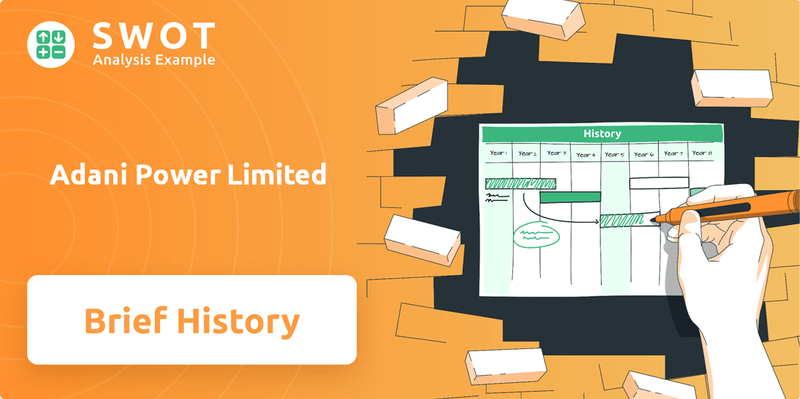
This journey, marked by key milestones and strategic shifts, reveals the Adani Power Limited SWOT Analysis, its evolution, and its impact on the Indian power sector. Exploring the brief history of Adani Power Limited provides valuable insights into the company's growth, challenges, and its position as one of India's largest private thermal power producers. Understanding the Adani Group's vision and the early days of Adani Power helps to appreciate its current standing.
What is the Adani Power Limited Founding Story?
Adani Power Limited was established in August 1996 as a part of the Adani Group, founded by Gautam Adani. The Adani Group saw a significant opportunity in India's growing power sector, which was facing considerable power shortages. Gautam Adani recognized the potential of large-scale power generation to support India's economic expansion.
The company's initial strategy centered on building large thermal power projects. This approach utilized the Adani Group's expertise in infrastructure and logistics, especially in coal handling through its port operations. The Mundra Thermal Power Plant in Gujarat was the first major project, strategically located near the Mundra port for efficient coal imports and coastal access for power distribution. Funding for these projects came from the Adani Group, financial institutions, and strategic partnerships.
The name 'Adani Power' directly reflected its core business within the Adani Group, emphasizing its role in the energy sector. The founding team, led by Gautam Adani, had a strong background in large-scale project execution and a deep understanding of India's infrastructure needs. This expertise allowed them to navigate the complex regulatory and operational environment of the power industry. Learn more about the company's core values by reading Mission, Vision & Core Values of Adani Power Limited.
Adani Power Limited's early days were marked by strategic infrastructure development and a focus on thermal power generation.
- Founded in August 1996 as part of the Adani Group.
- Focused on large-scale thermal power projects to address India's power deficits.
- Leveraged the Adani Group's expertise in infrastructure and logistics.
- The Mundra Thermal Power Plant was the first major project.
Adani Power Limited SWOT Analysis
- Complete SWOT Breakdown
- Fully Customizable
- Editable in Excel & Word
- Professional Formatting
- Investor-Ready Format
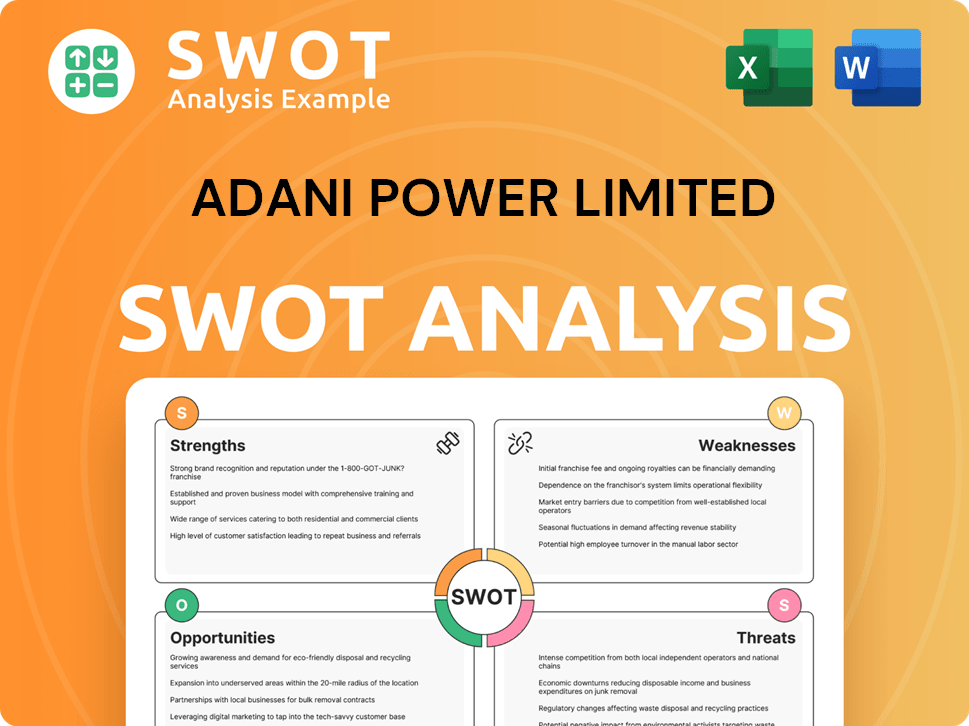
What Drove the Early Growth of Adani Power Limited?
The early growth of Adani Power Limited was marked by aggressive capacity expansion, primarily in thermal power generation. Following the conceptualization of the Mundra Thermal Power Plant, the company quickly acquired land and secured clearances. The first unit of the Mundra plant became operational in 2009, a significant milestone for the company.
Adani Power's initial focus was on the Mundra Thermal Power Plant. The company rapidly commissioned additional units, establishing it as one of India's largest single-location thermal power plants. This rapid expansion demonstrated the company's ability to execute large-scale projects efficiently. This early success set the stage for future growth.
Adani Power expanded its footprint beyond Gujarat, initiating projects in states like Rajasthan, Maharashtra, Karnataka, and Chhattisgarh. Key acquisitions and partnerships were crucial for this expansion, allowing the company to leverage existing infrastructure. This strategic move helped diversify its portfolio and reduce regional risk.
Acquisitions, such as the Essar Power's Mahan plant, played a significant role in boosting capacity. The company focused on integrating its operations, including backward linkages to coal mines and forward linkages to transmission lines. These strategic moves aimed to enhance efficiency and reduce operational costs.
Market reception to Adani Power's growing capacity was generally positive, driven by India's rising electricity demand. The company emphasized long-term power purchase agreements (PPAs) to ensure revenue stability. Strategic shifts included a greater focus on securing PPAs to attract further investment. For more information on the Owners & Shareholders of Adani Power Limited, please see our related article.
Adani Power Limited PESTLE Analysis
- Covers All 6 PESTLE Categories
- No Research Needed – Save Hours of Work
- Built by Experts, Trusted by Consultants
- Instant Download, Ready to Use
- 100% Editable, Fully Customizable
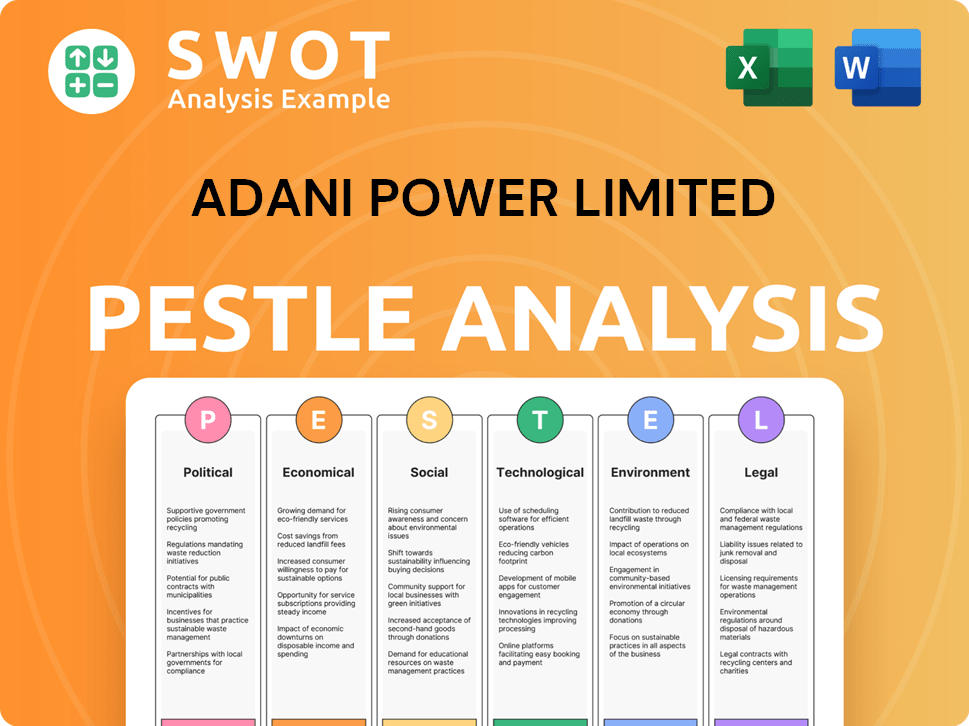
What are the key Milestones in Adani Power Limited history?
The journey of Adani Power Limited, a prominent player in the Indian power sector, is marked by significant milestones, strategic innovations, and considerable challenges, reflecting its growth and evolution within the dynamic energy landscape. A brief Adani Power history reveals a trajectory of ambitious projects and strategic adaptations.
| Year | Milestone |
|---|---|
| 2009 | Commissioning of the Mundra Thermal Power Plant, a key project that significantly increased the company's power generation capacity. |
| 2012 | Mundra Thermal Power Plant becomes the first Indian power project to achieve 4,620 MW capacity at a single location. |
| 2014 | Adani Power acquires Udupi Power Corporation Limited, expanding its operational footprint and generation capacity. |
| 2019 | Adani Power completes the acquisition of the thermal power assets of Essar Power, further consolidating its position in the power generation market. |
| 2023 | Adani Power reported a consolidated profit after tax of ₹10,727 crore for the fiscal year 2023. |
Adani Power has consistently focused on technological advancements to enhance efficiency and reduce environmental impact. The company has adopted supercritical and ultra-supercritical technology in its newer plants, improving efficiency. Furthermore, Adani Power has explored renewable energy sources, diversifying its energy mix and contributing to sustainable power generation.
Implementation of advanced technologies in power plants to enhance efficiency.
Strategic investments in renewable energy projects to diversify the energy portfolio.
Adani Power has faced several challenges that have shaped its operational and financial strategies. Fluctuations in coal prices, both domestic and international, have directly impacted operational costs. Regulatory hurdles and environmental clearances have often led to project delays and increased expenses. The company has also navigated issues related to the financial health of discoms and delayed payments, which have affected revenue realization. For a deeper understanding of the competitive landscape, you can refer to Competitors Landscape of Adani Power Limited.
Fluctuations in coal prices, impacting operational costs and profitability.
Delays and increased expenses due to regulatory and environmental clearance processes.
Challenges related to the financial stability of distribution companies and delayed payments.
Adani Power Limited Business Model Canvas
- Complete 9-Block Business Model Canvas
- Effortlessly Communicate Your Business Strategy
- Investor-Ready BMC Format
- 100% Editable and Customizable
- Clear and Structured Layout
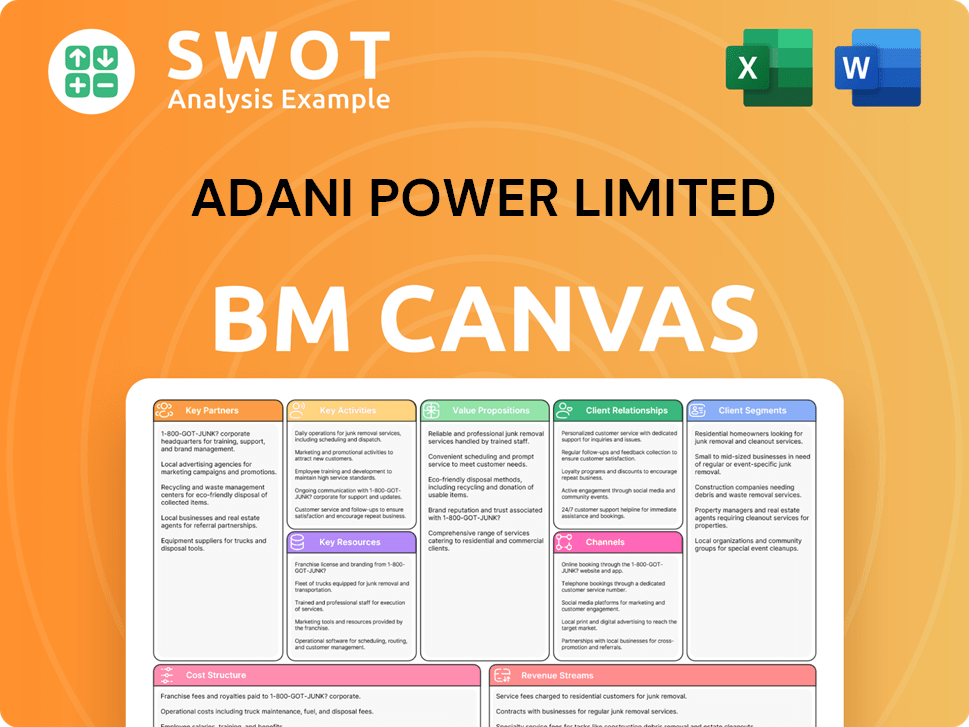
What is the Timeline of Key Events for Adani Power Limited?
The Adani Power Limited journey began in 1996, evolving into a major player in the Indian power sector. The company's history is marked by strategic acquisitions, capacity expansions, and significant contributions to power generation across India. Starting with the establishment of its first power plant in Mundra, Gujarat, the company has consistently increased its generation capacity. Adani Power's growth reflects its commitment to meeting India's growing energy demands.
| Year | Key Event |
|---|---|
| 1996 | Adani Power Limited is founded as a subsidiary of the Adani Group. |
| 2009 | The first unit of the Mundra Thermal Power Plant in Gujarat begins commercial operations. |
| 2012 | Mundra Thermal Power Plant reaches a capacity of 4,620 MW, becoming the largest single-location thermal power plant in India at the time. |
| 2014 | Commissioning of the Tiroda Thermal Power Plant in Maharashtra and the Kawai Thermal Power Plant in Rajasthan. |
| 2015 | Commissioning of the Udupi Thermal Power Plant in Karnataka. |
| 2018 | Acquisition of GMR Chhattisgarh Energy Ltd.'s 1,370 MW thermal power plant in Raikheda, Chhattisgarh. |
| 2020 | Adani Power achieves a significant milestone in its operational capacity. |
| 2022 | Adani Power acquires Essar Power's Mahan power plant, further expanding its generation capacity. |
| 2023 | Adani Power reports a significant rise in net profit, reflecting improved operational performance and favorable market conditions. |
| 2024 | Adani Power continues to focus on optimizing its existing assets and exploring opportunities for further growth, including potential acquisitions and expansion into renewable energy. |
| 2025 | As of Q4 FY24, Adani Power's consolidated net profit saw a remarkable increase, indicating strong financial health and operational efficiency. The company's total installed capacity stands at 15,250 MW. |
Adani Power is poised for continued growth, driven by India's escalating energy demand. The company is focusing on optimizing its existing thermal power assets and exploring new opportunities. This includes potential acquisitions and expansion into renewable energy sources to diversify its portfolio.
The company's long-term strategy includes strengthening its transmission and distribution infrastructure. Adani Power aims to leverage its large-scale generation capabilities and the Adani Group's integrated approach to the energy sector. The focus is on reliable power supply and sustainable growth.
Industry trends, such as the increasing focus on decarbonization and cleaner energy, are likely to influence Adani Power's future investments. This could accelerate its transition towards a more balanced energy portfolio. The company is adapting to evolving energy landscapes.
As of Q4 FY24, the company's consolidated net profit saw a remarkable increase, indicating strong financial health and operational efficiency. Adani Power is committed to powering India's progress. The total installed capacity stands at 15,250 MW as of 2025.
Adani Power Limited Porter's Five Forces Analysis
- Covers All 5 Competitive Forces in Detail
- Structured for Consultants, Students, and Founders
- 100% Editable in Microsoft Word & Excel
- Instant Digital Download – Use Immediately
- Compatible with Mac & PC – Fully Unlocked
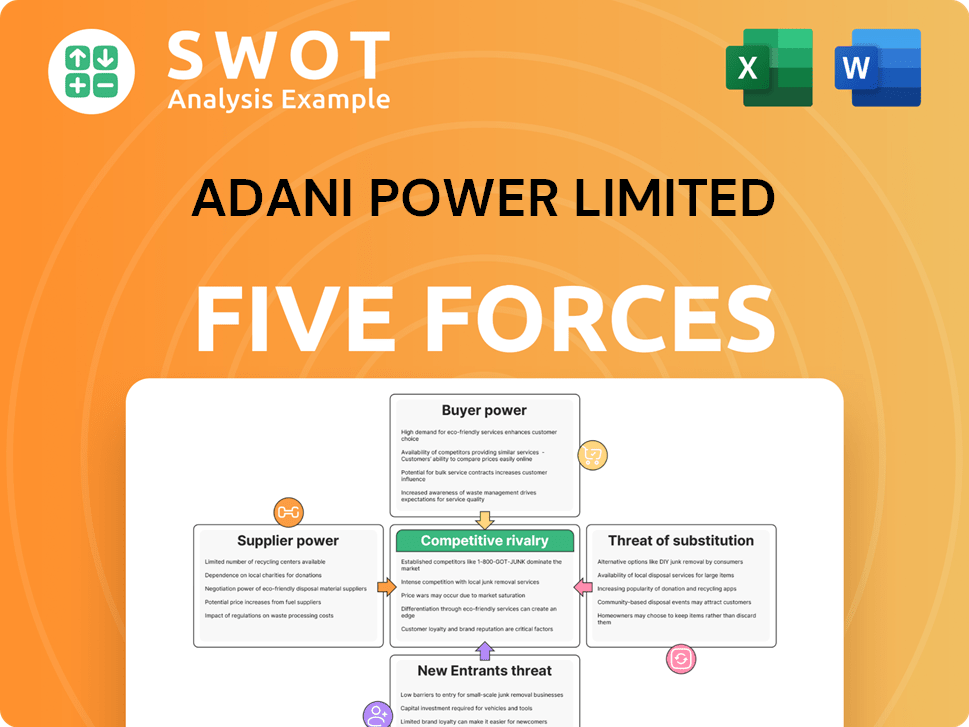
Related Blogs
- What is Competitive Landscape of Adani Power Limited Company?
- What is Growth Strategy and Future Prospects of Adani Power Limited Company?
- How Does Adani Power Limited Company Work?
- What is Sales and Marketing Strategy of Adani Power Limited Company?
- What is Brief History of Adani Power Limited Company?
- Who Owns Adani Power Limited Company?
- What is Customer Demographics and Target Market of Adani Power Limited Company?
Disclaimer
All information, articles, and product details provided on this website are for general informational and educational purposes only. We do not claim any ownership over, nor do we intend to infringe upon, any trademarks, copyrights, logos, brand names, or other intellectual property mentioned or depicted on this site. Such intellectual property remains the property of its respective owners, and any references here are made solely for identification or informational purposes, without implying any affiliation, endorsement, or partnership.
We make no representations or warranties, express or implied, regarding the accuracy, completeness, or suitability of any content or products presented. Nothing on this website should be construed as legal, tax, investment, financial, medical, or other professional advice. In addition, no part of this site—including articles or product references—constitutes a solicitation, recommendation, endorsement, advertisement, or offer to buy or sell any securities, franchises, or other financial instruments, particularly in jurisdictions where such activity would be unlawful.
All content is of a general nature and may not address the specific circumstances of any individual or entity. It is not a substitute for professional advice or services. Any actions you take based on the information provided here are strictly at your own risk. You accept full responsibility for any decisions or outcomes arising from your use of this website and agree to release us from any liability in connection with your use of, or reliance upon, the content or products found herein.